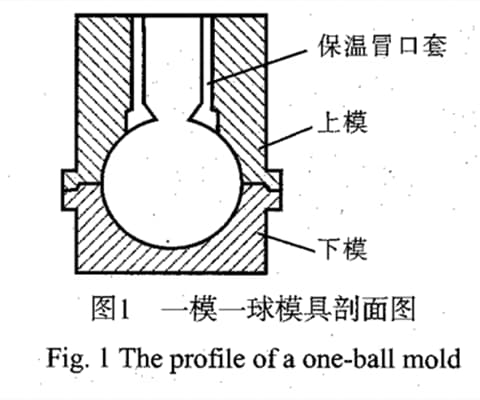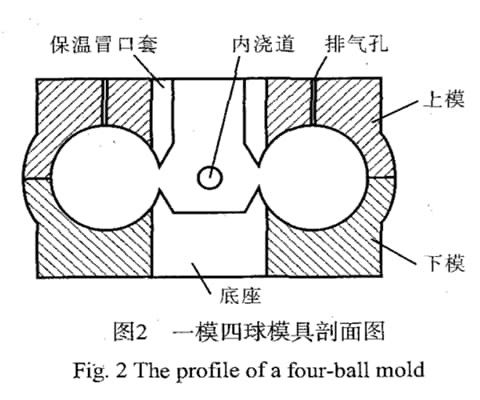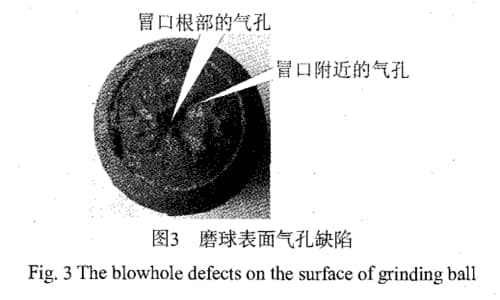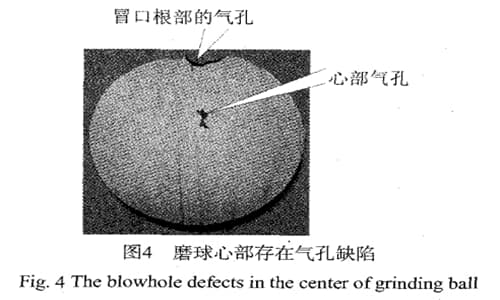Influence of Filling Modes on Blowhole Defects of High Chromium Cast Iron Grinding Ball (1)
He Guo—Qiang
(Jin Dui Cheng Molybdenum Group Co., Ltd.,Huaxian714102,Shanxi,China)
Abstract: To solve the problem of the blowhole defects in the center and on the high chromium cast iron grinding ball’s surface, the influence of the two filling modes—one-ball mold and four-ball mold on blowhole defects were analyzed. The result indicated that the four-ball m old’s venting effect with parting—line gating system is better. The impact of liquid iron is smaller,and the filling is relatively steady as compared with that of the one-ball mold with top gating system,therefor the gas is not easy to be entrapped.So for high chromium cast iron grinding ball whose carbide is (Cr,Fe)7C3,the blowhole defects could be eliminated using the four-ball mold with parting—line gating system.
Keywords:filling mode;high chromium cast iron;cast iron grinding ball; blowhole defect
Cast Iron Grinding ball is widely used in mines, metallurgy, building materials, and electric power industries; the industry’s main wearing parts is the abrasive medium ball mill. The common materials of casting grinding ball are mainly chromium alloy cast iron and silicon manganese alloy bainite ductile iron. The M7C3 type carbide is distributed in the microstructure of high chromium cast iron grinding ball, which makes it have higher hardness and better toughness. Compared with other grinding balls, it has the advantages of low unit consumption and low crushing rate, so it has attracted material technicians’ attention. However, in the actual production process, there are air hole defects in the core of the grinding ball, the root section of the riser, and the surface near the riser, which affect the quality of the grinding ball, especially the air hole defect in the core, and destroy the continuity of the grinding ball, that caused the ball to fail early. Therefore, it is necessary to study the characteristics of the cast grinding ball’s filling pattern to eliminate the defects of air holes in the center of the ball, the root section of the riser, and the surface near the riser.
In this paper, the effect of mold filling on the porosity of cast iron grinding ball is analyzed in order to eliminate the porosity and improve the quality of high chromium cast iron grinding ball.
1.Test requirements
The cast iron grinding ball is 120mm in diameter and made of high chromium cast iron with 13% ~ 15% chromium content. The casting process is as follows.
The scheme I: The mold adopts one mold and one ball mold, I. E. Single Mould. The upper and lower mold and insulation riser sleeve composition, after closing the section schematic diagram, are shown in figure.1
Scheme II: The mold adopts one mold and four-ball mold. It consists of upper and lower molds and ramming gating and riser systems at the production site. The Section Diagram after mold closing is shown in Fig. 2
2.Test process and results
After melting the metal charge in 2T medium-frequency Coreless Induction Furnace, the molten iron in the same ladle was poured into the metal mold of the two schemes respectively, and the comparative experiment of filling mode was carried out.
After shovel cleaning, the quality of dia120mm grinding balls of the two schemes was examined, and the results are as follows.
The root section of the riser and the surface near the riser of the grinding ball in the scheme I have gas-relict defects (as shown in Fig. 3), the inner surface is smooth and elliptical, and the ball is cut by wire cutting machine along the center of the riser, in the section, there are stomatal defects in the direction of the riser, inner surface, smooth surface and irregular shape (Fig. 4). There is no pore defect in the root section of the riser and the surface near the grinding ball’s riser in scheme II. The ball is cut by wire cutting machine along the center of the riser, and there is no pore defect in the profile (Fig. 5).





